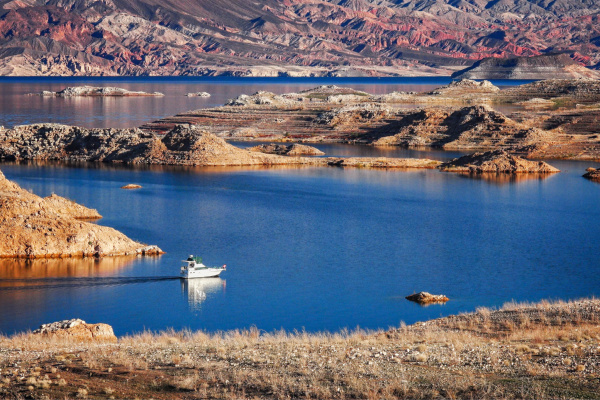It appears that the Southwest’s crippling drought has a morbid side effect: bodies long gone into the depths of what was once a deep Lake Mead are being revealed as the lake levels drop to historic lows. More human remains were found at Lake Mead less than a week after a body in a barrel was found stuck in the drying lake bed.
As AccuWeather reports, two sisters from the Las Vegas suburb of Henderson had been paddle boarding in the Callville Bay area of Lake Mead on Saturday, May 7, when they spotted the remains and contacted the National Park rangers. Linsey Melvin, one of the sisters, told KLAS-TV that at first, she had thought the remains belonged to a bighorn sheep until she and her sister continued to dig and instead found what appeared to be a human jawbone.
Rangers with the National Park Service responded to the call on Saturday and recovered the remains, which were confirmed to be human. “The Clark County medical examiner has been contacted to determine the cause of death, which may take several weeks to complete,” Lake Mead National Recreation Area Public Affairs Office told AccuWeather via email. “The park does acknowledge that as water levels continue to decline there may be additional discoveries made. The park has no additional comments on the investigation at this time.” Investigators aren’t treating this case as a homicide, Las Vegas police told The Associated Press (AP).
The state border between Nevada and Arizona runs down the center of Lake Mead with Callville Bay branching off from the reservoir on the Nevada shoreline. The set of human remains found in Lake Mead last week was also found on the Nevada side of the lake. “I would say there is a very good chance as the water level drops that we are going to find additional human remains,” Las Vegas Metropolitan Police Homicide Lieutenant Ray Spencer had told KLAS-TV on Monday, May 2, after the first body had been found.
In the time between the two sets of remains being found, the water level had dropped by roughly one foot, going from 1,054.4 feet above sea level to 1053.1 feet above sea level, and it’s continued to steadily plunge. As of Monday, May 9, Lake Mead’s water level sat at 1,052.88 feet above sea level — a far cry from its highest recorded level of over 1,225 feet, reached during the summer of 1983 during a strong El Niño phase that brought widespread flooding to the United States and pushed at least one dam along the Colorado River nearly to its breaking point.
It’s a sharp contrast compared to last week, when one of Lake Mead’s intake valves stuck out above the water line for the first time, according to the Southern Nevada Water Authority, which manages the water supply for the Las Vegas area. Then as recently as Monday, Echo Bay limited its launch ramps to vessels with shallow hulls. Three harbors had already been closed due to low water levels.
The plunging water levels at the reservoir gained national attention in August 2021 after the Bureau of Reclamation said that Lake Mead had dropped to 35% capacity, leading to the first-ever water shortage declaration in the Colorado River Basin and prompting water consumption cuts across the Southwest. But Lake Mead is not the only body of water facing the consequences of the drought that has gripped the North American Southwest for over 22 years.
According to AccuWeather, the combination of river diversions and impacts from the drought has driven Utah’s Great Salt Lake to some of the lowest levels since the USGS began keeping records back in 1847, impacting systems dependent on it from the ecosystem to the local area’s economy. Then at Lake Powell, also in Utah, a family out fishing discovered more than just fish when they stumbled upon a shipwrecked boat that had been revealed by receding waters in April 2021. Farther west, a small airplane that officials believed crashed in 1986 was found at the bottom of California’s Folsom Lake in June 2021.
The Southwest and parts of northern Mexico experienced their driest 21-year stretch from 2000 to 2021 in at least 1,200 years, according to a peer-review study published in the journal Nature Climate Change in February 2022. About 19% of the “exceptional drought severity” in 2021 that pushed this megadrought into its current ranking was attributed to human-caused climate trends.
—
Photo Credit: CrackerClips Stock Media / Shutterstock.com
